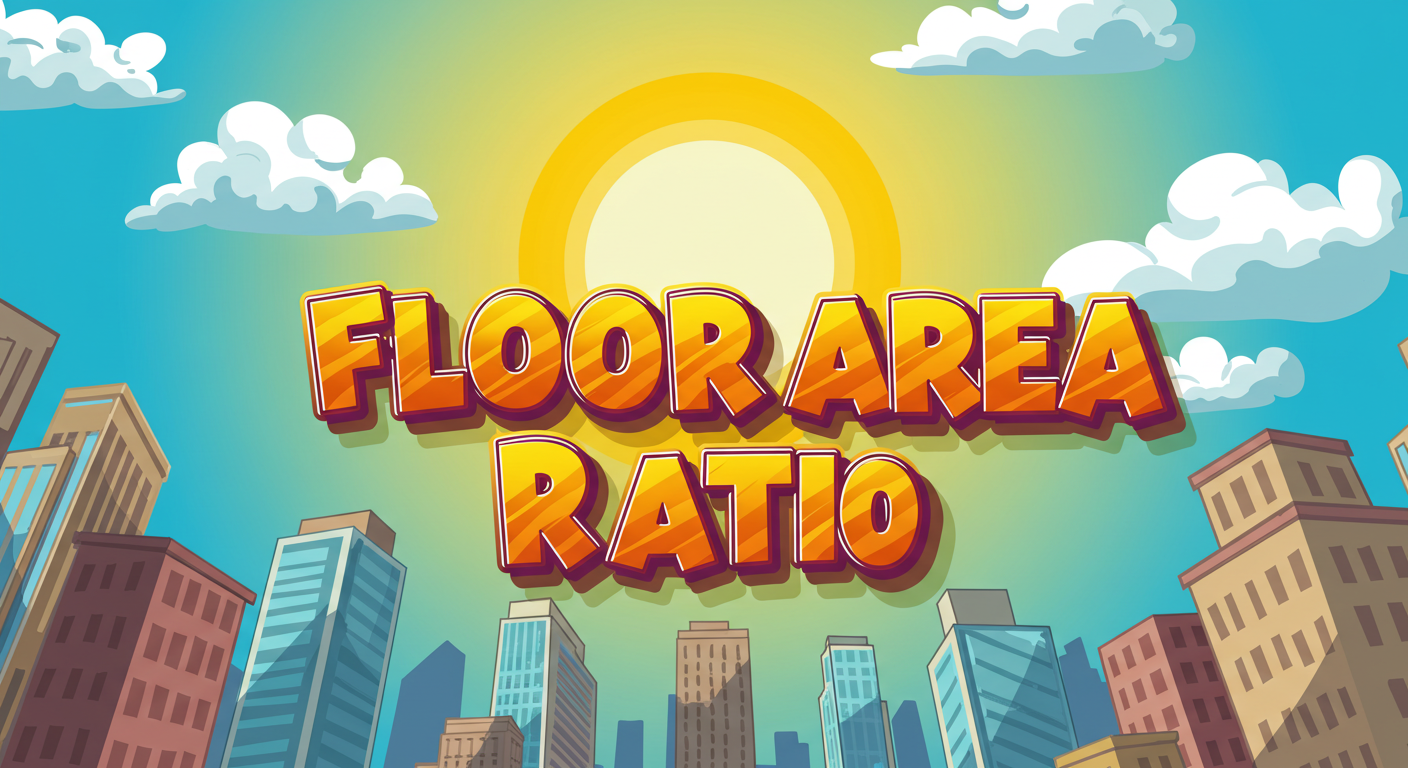Floor Area Ratio (FAR) in Property Management: The Complete Guide
Floor Area Ratio is the ratio of a building's total floor area to the size of the lot it occupies; you calculate FAR by dividing your building's gross floor area by your lot area

Here's a mind-blowing fact that might surprise you: A single basement can increase your Floor Area Ratio by 50%, while adding a typical two-car garage boosts it by 20%. These seemingly simple additions can dramatically transform your property's compliance status, development potential, and market value—sometimes by hundreds of thousands of dollars.
Property managers face countless regulations, but few impact development potential and property values as directly as Floor Area Ratio (FAR).
This zoning metric determines exactly how much building space you can construct on any given lot. It's a critical factor in investment decisions, tenant density planning, and long-term profitability.
In this article, you'll learn what FAR means in practical terms, how it affects your bottom line, the legal risks of non-compliance, and proven strategies for leveraging FAR in your property management operations.
Quick Answer: What You Need to Know Right Now
Floor Area Ratio (FAR) is calculated by dividing total building floor area by lot size. Most residential zones allow 0.40-0.48 FAR, while commercial zones can reach 3:1 or higher. FAR directly impacts property value, rental income potential, and development rights. Properties with higher allowable FAR typically command 15-20% premiums due to greater development flexibility.
What Is Floor Area Ratio (FAR)?
Floor Area Ratio is the ratio of a building's total floor area to the size of the lot it occupies. You calculate FAR by dividing your building's gross floor area by your lot area. A FAR of 1.0 means your building's total floor space equals your lot size—like having a 2,000-square-foot building on a 2,000-square-foot lot.
The floor area ratio goes by several names depending on your location. Some municipalities use "Floor Space Index" (FSI), though the calculation remains identical. Government planning organizations define FAR as "the measurement of a building's floor area in relation to the size of the lot/parcel that the building is located on, expressed as a decimal number."
What makes FAR tricky is that definitions vary significantly across jurisdictions. New York City includes basements in floor area ratio calculations but excludes cellars. Portland measures floor area "from the exterior faces of a building" and includes garages. Houston excludes detached parking garages up to 528 square feet.
These variations can dramatically impact your property's compliance status. A building that meets FAR requirements in one city might violate them in another due to definitional differences about what counts toward total floor area.
Lower maximum FAR limits typically correlate with lower land use density and reduced property values. Higher FAR allowances enable more intensive development and greater revenue generation.
When planning capital improvements that affect building footprint or height, FAR calculations become critical for maintaining compliance while maximizing investment returns.
Property Value Impact Chart
How to Calculate Floor Area Ratio: Step-by-Step Process
Step 1: Measure your total lot area in square feet
Step 2: Calculate gross floor area from exterior wall faces
Step 3: Subtract local exclusions (parking garages, basements, mechanical rooms)
Step 4: Divide adjusted floor area by lot area
Example: 4,500 sq ft building ÷ 10,000 square feet lot = 0.45 FAR
The formula remains consistent: FAR = gross floor area ÷ area of the plot. However, what counts toward your gross floor area varies dramatically between jurisdictions, making local knowledge essential for accurate calculations.

Our Cap Rate Calculator helps evaluate how FAR-related improvements impact your investment returns.
Impact & Applications: Why FAR Matters for Your Bottom Line
Operational Impact
Floor area ratio fundamentally shapes your property's financial performance through density control and development limitations. Government planning authorities use FAR to estimate potential impacts of proposed developments, including employee counts and vehicle trips per square foot of building space.
The financial implications are substantial. Research shows that stringent limits on floor area ratios lead to less housing supply and higher rents. Properties with higher FAR allowances command premium prices because they offer greater development potential. For commercial properties, larger FAR serves as an incentive for providing larger lots, encouraging lot consolidation for more comprehensive developments.
Missing FAR compliance details could cost you thousands in permit delays and forced modifications. Local governments integrate FAR calculations into building permit applications and zoning compliance reviews. Properties exceeding FAR limits face stop-work orders, forced demolitions, or expensive redesigns.
FAR affects different property types distinctly. Industrial, residential, commercial, agricultural, and nonagricultural spaces have differing safe load factors, so they typically have differing floor area ratios. Residential zones commonly establish FAR limits ranging from 0.40 to 0.48 depending on lot size. Commercial zones may allow FAR ratios of 3:1 or higher for dense urban area development.
Population density regulations tie directly to FAR limits. Areas zoned for higher density typically allow greater floor area ratios to accommodate more dwelling units per acre. This relationship between FAR and density makes understanding these limits crucial for maximizing rental income and property utilization in build-to-rent developments.
3D Building Configuration Comparison
FAR Impact on Property Values: The Numbers
Here's what the data reveals about FAR's financial impact:
- Properties with 1.0+ FAR allowances trade at 15-20% premiums
- Every 0.1 FAR increase can boost property value by $50-75 per square foot
- Buildings at maximum FAR generate 25-40% higher rental income per lot
- FAR restrictions below 0.3 correlate with 30% lower development density
Real-World Application
Example: Maximizing Rental Income Through FAR Optimization
Challenge: A property management firm in Austin acquired a 10,000 square feet lot in a residential zone with a 0.45 FAR limit, seeking to maximize rental units while maintaining compliance.
Solution: The team calculated their maximum allowable gross floor area at 4,500 square feet (10,000 × 0.45). Instead of building a single-story structure covering most of the lot, they designed a three-story building with a smaller footprint. This approach utilized the full FAR allowance while providing better open space and parking options. They excluded the parking garage from FAR calculations per local guidelines, adding 800 square feet of covered parking without affecting their ratio.
Outcome: The optimized design yielded six rental units instead of the four originally planned, increasing potential rental income by 50%. The additional floor space generated an extra $2,400 monthly in rental revenue while maintaining full zoning regulation compliance.
Takeaway: Strategic FAR planning enables property managers to maximize usable floor area without violating zoning laws. Understanding exclusions like parking garages and basements can add valuable space without impacting your FAR calculation.
State-by-State FAR Variations: What Property Managers Must Know
FAR regulations vary dramatically across states due to different planning philosophies and urban density goals. Understanding these variations is crucial for multi-state property management operations.
FAR Requirements Vary Significantly by State
California: Senate Bill 478 proposes minimum FAR requirements for multi-family developments. Some cities like Los Angeles allow 1.5-6.0 FAR for residential zones with affordable housing density bonuses.
New York: Includes basements in FAR calculations but excludes cellars. NYC FAR ranges from 0.5-15+ depending on zoning district. Manhattan commercial zones can reach exceptionally high FAR limits for dense urban development.
Texas: Houston excludes detached garages up to 528 square feet. Residential FAR typically ranges 0.4-0.6 for single-family properties. Commercial zones vary significantly by district.
Oregon: Portland measures floor area "from exterior building faces" and includes all garages. FAR limits integrate with urban planning goals for population density control.
Illinois: Chicago allows 0.5-5.0 FAR with density bonuses available for affordable housing inclusion. Zoning districts in downtown areas permit higher FAR ratios.
Washington: Seattle permits 0.75-3.0 FAR with affordable housing incentives. Urban area planning emphasizes higher density through increased FAR allowances.
These state-level differences affect property values, development potential, and compliance requirements. Properties near state borders may benefit from jurisdiction shopping for more favorable FAR allowances.
Legal & Compliance Essentials
Zoning regulations establish FAR requirements that vary dramatically by jurisdiction and zoning district. Local governments maintain authority over FAR limits, creating a complex patchwork of requirements that property managers must navigate carefully.
FAR Violation Consequences Property Managers Face
• Stop-work orders halting construction projects
• Forced demolition of non-compliant structures
• Permit denial for certificate of occupancy
• Legal liability for tenant displacement
• Financial penalties up to $50,000 in some jurisdictions
Compliance documentation requires maintaining accurate records of all floor space calculations, including detailed plans showing gross floor area measurements and exclusions. Properties must demonstrate adherence to height limits, lot coverage requirements, and FAR standards simultaneously.
Key Legal Considerations
Documentation requirements: Municipal planning departments require diagrams showing how projects meet floor area ratio standards during permit applications. These must include:
- Detailed floor area measurements from exterior wall faces
- Clear identification of exclusions (elevator shafts, parking garages, mechanical spaces)
- Calculation worksheets showing FAR compliance
- Site plans indicating lot lines and building size relationships
Measurement standards: Floor area calculations must follow specific guidelines. Portland measures "from exterior faces of buildings" while other jurisdictions use different standards. Always verify local measurement requirements before submitting plans.
Exclusion rules: What counts toward your FAR varies significantly. Some areas exclude elevator shafts, basements, and parking garages while others include them. Houston excludes detached garages under 528 square feet. New York includes basements but not cellars.
State-level intervention in local FAR control is increasing. California's Senate Bill 478 proposes establishing minimum floor area ratios that cities must allow for residential developments, representing significant change in traditional local zoning code authority.
The biggest compliance risk occurs when property managers assume FAR definitions are universal. Always verify local requirements before planning modifications or new construction, as definitions can vary dramatically even between neighboring municipalities.
Best Practices for Floor Area Ratio Management
1. Master Your Local FAR Definitions and Exclusions
Understanding your specific zoning code prevents costly mistakes and maximizes development potential. Contact your local planning department to obtain detailed FAR calculation guidelines, including what spaces count toward total area and which exclusions apply. Many jurisdictions exclude basements, parking garages under certain sizes, and mechanical spaces from FAR calculations—knowledge that can add valuable square footage to your projects.
Create a reference document for each zoning district where you operate. Include local definitions, exclusion lists, and calculation examples. This becomes invaluable when planning renovations or new construction projects.
2. Leverage Technology for Accurate FAR Tracking
Property management software with integrated zoning compliance features streamlines FAR monitoring and documentation. Use digital tools to maintain detailed records of gross floor area calculations, track changes over time, and generate compliance reports for permit applications. Several platforms now offer automated FAR calculations that update as you modify building plans.
Consider these technological solutions: • CAD software with built-in FAR calculation tools
• Property management platforms with zoning integration
• Digital measurement tools for accurate floor area calculations
• Cloud-based documentation systems for compliance records
3. Plan Strategically for Maximum Density Within FAR Limits
Vertical development often provides better returns than horizontal expansion when dealing with restrictive FAR limits. Consider multi-story designs that maximize floor space while maintaining smaller lot coverage footprints. This approach typically allows for better amenities, parking, and open space while fully utilizing your allowable square footage.
Design principles for FAR optimization: • Minimize building size footprint to allow for amenities
• Utilize full height limits permitted by zoning ordinances
• Plan parking garages to take advantage of FAR exclusions
• Design open space that enhances property value without affecting FAR
4. Coordinate FAR Planning with Parking and Amenity Requirements
Successful FAR optimization requires balancing multiple zoning requirements simultaneously. Many zoning ordinances exclude parking garages from FAR calculations while requiring minimum parking ratios. Design projects that meet parking requirements through excluded structures, freeing up FAR allowance for revenue-generating floor area.
Coordinate these elements: • Parking requirements vs. FAR exclusions for garages
• Open space mandates vs. lot coverage limits
• Height limits vs. density goals
• Setback requirements vs. building size optimization
Understanding Related Zoning Concepts
What Makes FAR Different from Other Zoning Measurements
Floor Area Ratio works alongside other zoning controls to shape development. Understanding these relationships helps property managers optimize their projects within regulatory frameworks.
Floor Area vs. Lot Area: Floor area measures the total square footage inside a building from exterior wall faces. Lot area measures the total area of the land parcel. FAR expresses their relationship as a ratio.
FAR vs. Lot Coverage: Floor area ratio accounts for all floors in a building, while lot coverage only measures the building's footprint on the ground. A three-story building and a one-story building covering the same ground area have identical lot coverage but drastically different FARs.
Building Coverage Ratio: This measures what percentage of your lot area the building footprint occupies. Unlike FAR, it doesn't consider building height or multiple floors.
Density Calculations: Population density and dwelling unit density work alongside FAR to control neighborhood character. Higher FAR typically allows more units per lot.
Related Property Management Terms
Floor Space Index (FSI): Alternative term for FAR used in some jurisdictions. The difference between FAR and FSI is that the first is a ratio, while the latter is an index. An FAR of 1.5 translates as an FSI of 150%.
Bulk Regulations: Zoning codes that control building mass, including FAR, height limits, and setbacks. These work together to shape neighborhood character.
Density Bonuses: FAR increases granted for including affordable housing or other community benefits. These can significantly boost allowable floor space.
Setback Requirements: Distance requirements from property lines. These affect building size and placement while working alongside FAR limits.
Key Questions Answered: FAR Fundamentals
What is the floor area ratio?
Floor Area Ratio (FAR) measures the relationship between a building's total floor space and the lot size it occupies.
You calculate it by dividing gross floor area by lot area. A 1.0 FAR means your building's total floor area equals your lot size—like a 5,000-square-foot building on a 5,000-square-foot lot.
How is floor area ratio calculated?
FAR calculation involves four simple steps: measure your lot area, calculate gross floor area from exterior walls, subtract local exclusions (like parking garages or basements), then divide adjusted floor area by lot area. The calculation process follows the formula: FAR = gross floor area ÷ lot area.
Why is floor area ratio important?
FAR directly controls development density and property value. It determines how much usable floor area you can build, affecting rental income potential and investment returns. Properties with higher allowable FAR command premium prices due to greater development flexibility and revenue generation capability.
What does the floor area ratio tell you?
FAR reveals a property's development intensity and remaining growth potential. Low FAR indicates underutilized land with expansion opportunities. High FAR suggests maximum development density. Commercial zones typically allow higher FAR than residential areas to accommodate urban density goals.
How much does FAR affect property value?
Properties with higher allowable FAR typically command 15-20% premiums due to greater development potential and revenue generation capability. Every 0.1 FAR increase can boost property value by $50-75 per square foot in many markets.
Can I exceed my property's FAR limit?
No. Exceeding FAR limits violates zoning regulations and can result in stop-work orders, forced modifications, or permit denial. Always verify compliance before construction. Some jurisdictions offer density bonuses or variances, but these require formal approval processes.
What are the zoning regulations for FAR in commercial real estate?
Commercial FAR regulations vary dramatically by zoning district and jurisdiction. Urban areas typically allow higher FAR (3:1 to 15:1) to encourage density. Commercial zones often use FAR alongside height limits and lot coverage requirements to control development character. Professional planning organizations note that FAR works in conjunction with other development standards.
How can you find out what zoning district your property is located in?
Contact your local planning department or search online zoning maps available on most municipal websites. Many cities provide interactive maps showing zoning districts, FAR limits, and other restrictions. Property deeds sometimes include zoning information, though regulations may have changed since purchase.
What is zoning and why might your project require zoning relief?
Zoning regulations control land use, building density, and development character through tools like FAR limits. Projects may need zoning relief (variances or rezoning) when proposed development exceeds current FAR allowances or conflicts with height limits, setbacks, or use restrictions. Modern zoning applications developed through special commissions appointed in 1913 and 1916 by New York City's Board of Estimate and Apportionment.
What are the drawbacks of higher FAR in commercial real estate?
Higher FAR can create infrastructure strain, parking shortages, and neighborhood character conflicts. Dense development may overwhelm utilities, increase traffic, and reduce open space. However, these challenges often balance against increased rental income and property values.
How do you calculate the floor area of a building?
Measure each floor from exterior wall faces and sum the totals. Include all enclosed spaces like elevator shafts, stairwells, and storage areas. Government sources specify that FAR includes primary structures, sunrooms or enclosed porches with walls and windows, and attached garages. Exclude unenclosed spaces like balconies, porches, and courtyards unless local zoning codes specify otherwise.
Major Metro FAR Guidelines: Quick Reference
Understanding FAR limits in major markets helps property managers benchmark opportunities and plan investments strategically.
New York City: 0.5-15+ FAR depending on district. Manhattan commercial zones allow exceptionally high ratios. Residential areas typically range 0.5-2.4 FAR.
Los Angeles: 1.5-6.0 FAR for residential zones with affordable housing bonuses available. Commercial zones vary significantly by location and transit access.
Chicago: 0.5-5.0 FAR with density bonuses available for affordable housing inclusion. Downtown zoning districts permit higher ratios for urban density goals.
Houston: 0.4-0.6 FAR for single-family residential. Commercial zones allow higher ratios with special provisions for detached garage exclusions.
Seattle: 0.75-3.0 FAR with affordable housing incentives. Urban planning emphasizes higher density through increased FAR allowances near transit.
San Francisco: Varies dramatically by neighborhood. Some areas allow 3:1+ FAR while others restrict development to preserve character.
These variations reflect different urban planning philosophies, from Houston's relatively permissive approach to San Francisco's more restrictive character preservation focus.
Technological Solutions for FAR Management
Digital Tools for Accurate Calculations
Modern property management increasingly relies on technology for FAR compliance and optimization. These tools reduce errors and streamline the approval process.
CAD Software Integration: Many architectural programs now include automatic FAR calculations that update as you modify building designs. This prevents costly mistakes during the planning phase.
Property Management Platforms: Comprehensive software solutions offer zoning compliance modules that track FAR limits, generate reports, and maintain historical records for multiple properties.
Mobile Measurement Apps: Smartphone applications can calculate floor area and lot area using GPS and camera technology, providing quick estimates for preliminary planning.
GIS Mapping Tools: Geographic Information Systems help property managers identify zoning districts, research FAR limits, and analyze comparable properties in their markets.
Best Practices for Technology Implementation
Start with accurate base data: Ensure your property management system includes correct lot area measurements and current zoning district classifications for all properties.
Maintain historical records: Track FAR calculations over time to identify trends, document compliance, and plan future modifications.
Integrate with permit tracking: Connect FAR calculations to building permit applications and compliance monitoring systems.
Use cloud-based solutions: Ensure your FAR data is accessible to all team members and automatically backed up for compliance documentation.
Advanced FAR Strategies for Property Managers
Maximizing Development Potential
Lot consolidation strategies: Combine adjacent parcels to achieve economies of scale and higher effective FAR utilization. Larger lots often qualify for better FAR ratios in many zoning codes.
Phased development approaches: Plan projects in stages to optimize FAR usage while maintaining cash flow. This works particularly well for commercial zones with high FAR allowances.
Mixed-use optimization: Combine residential and commercial spaces to maximize floor space utilization within FAR limits. Some zoning ordinances offer bonuses for mixed-use development.
Parking structure strategies: Design parking garages to take advantage of FAR exclusions while meeting parking requirements. Underground or partially underground structures often don't count toward FAR.
Financial Modeling for FAR Decisions
Revenue per square foot analysis: Calculate how different FAR scenarios affect rental income potential and overall investment returns.
Development cost optimization: Balance construction costs against additional floor space enabled by higher FAR utilization.
Market timing considerations: Consider how FAR limits might change over time due to urban planning updates or state legislation like California's SB 478.
Exit strategy planning: Higher FAR utilization typically improves property values for future sales, but may require longer hold periods to realize full benefits.
Conclusion & Next Steps
Floor Area Ratio fundamentally impacts your property's development potential, compliance status, and long-term profitability. Master these three critical takeaways:
- Calculate FAR accurately using local definitions—variations between jurisdictions can dramatically affect compliance and available floor space
- Leverage exclusions strategically—understanding what doesn't count toward FAR (like certain parking garages or basements) can add valuable square footage
- Plan for maximum density within limits—vertical development often provides better returns than horizontal expansion when dealing with restrictive zoning regulations
Understanding FAR enables smarter investment decisions, better tenant density planning, and compliance confidence. Properties with higher allowable floor area ratios typically command premium prices due to their greater development flexibility and revenue potential.
The data is clear: every 0.1 FAR increase can boost property value by $50-75 per square foot. Buildings at maximum FAR generate 25-40% higher rental income per lot. These aren't theoretical benefits—they're measurable impacts on your bottom line.
Your Next Steps for FAR Optimization
Audit your current properties - Calculate existing FAR for all buildings and identify underutilized development potential
Research local exclusions - Contact planning departments to identify opportunities for additional square footage
Plan future developments - Design projects that maximize allowable FAR while meeting parking and open space requirements
Monitor zoning changes - Stay informed about FAR regulation updates, density bonuses, and affordable housing incentives in your markets
Ready to optimize your property management operations? Start with our Certificate of Occupancy guide for zoning compliance requirements. Check out our Capital Improvements resource to understand how structural modifications affect FAR calculations. Our Cap Rate Calculator helps evaluate how FAR-related improvements impact your investment returns.
For comprehensive property valuation insights, explore our Build-to-Rent guide to see FAR optimization in modern rental communities. Understanding affordable housing regulations? Our affordable housing resource explains how density incentives work with FAR bonuses.
Master FAR fundamentals and transform zoning regulations from obstacles into opportunities for maximizing your property's potential. The difference between mediocre and exceptional property management often comes down to understanding these regulatory details that drive real financial results.
Legal Disclaimer
The information on this website is sourced from publicly available materials and is provided for general informational purposes only. It is not intended as legal, financial, or accounting advice. LandlordDoc.com makes no guarantees about the accuracy or completeness of the information and assumes no liability for any errors, omissions, or outcomes related to its use.






